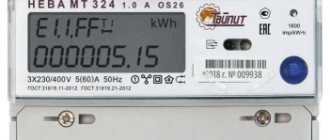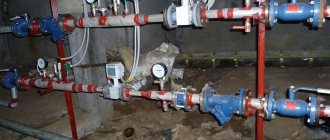Social norm for electricity
On September 1, 2013, a social standard for electricity supply was introduced in the Rostov region. This is the amount of electricity consumed, which is paid at a reduced tariff.
| Calculation of social norm | |
| Social norm for the first registered | 96 kW/h |
| Social norm for the second registered | 60 kW/h |
| Social norm on the following registered | 40 kW/h starting from the third and for each subsequent |
| Benefit for payment in the first year of the social norm for the entire volume of electricity consumption, and from the second year with the use of an increasing factor of 1.5 | Single pensioners and families of pensioners + - large families — families with disabled people (including disabled children); — families with children in care |
| Surcharge for electric stoves | 43 kWh per person, but not less than 90 kWh per household |
| Surcharge for electric water heating installations | 300 kWh per person |
| The degree of wear and tear of the housing stock | Emergency housing and housing with a degree of wear and tear of 70% or more |
| Seasonal allowances | The increasing coefficient is 1.1 in June, July and August, and the decreasing coefficient is -0.9 in February, March and April. |
No upper limit on the size of the social norm
An additional 40 kWh is charged for each registered person - the sixth, the seventh, and so on, without limitation.
List of preferential categories
At the initiative of the regional government, the list of preferential categories of citizens has been expanded. In addition to single pensioners, this list includes: large families, families with disabled people or children with disabilities, foster families and those in which children live without parental care.
The social norm for preferential categories of families is calculated using an increasing factor of 1.5.
In order to exercise this right, you need to contact the subscriber department of PJSC "TNS energo Rostov-on-Don" at your place of residence, where you must provide documents confirming your family status.
Seasonality coefficients
Taking into account the use of air conditioners in the Rostov region, a seasonality coefficient has been introduced. In June, July and August, an increasing coefficient of 1.1 is applied to the volume of social norms, and in February, March and April - a decreasing coefficient of 0.9 (approved by Resolution of the RST of the Rostov Region dated May 29, 2014 No. 23/2).
How to apply the seasonality factor? — The value of the social norm for the consumption of electrical energy is multiplied by the corresponding coefficient.
A simple example, 96 kW/h * 1.1 = 105.6 kW/h - this will be the summer social norm for a Donetsk resident living alone. Accordingly, in the months when air conditioning is not needed, the social norm will be adjusted downwards. All registered citizens are taken into account in the calculations.
| No. | Month | The value of the seasonality coefficient |
| 1 | January | 1 |
| 2 | February | 0,9 |
| 3 | March | 0,9 |
| 4 | April | 0,9 |
| 5 | May | 1 |
| 6 | June | 1,1 |
| 7 | July | 1,1 |
| 8 | August | 1,1 |
| 9 | September | 1 |
| 10 | October | 1 |
| 11 | November | 1 |
| 12 | December | 1 |
We calculate the social norm for electricity:
It is also important to know about the social norm for electricity:
- Social norm does not limit electricity consumption
- Electricity within the social norm is paid at a reduced rate
- The value of the social norm is established taking into account the general needs of the house
- If there is a metering device differentiated by day zones, it is used in proportion to the actual consumption by day zones
- Unused balance does not carry over to the next period
- Used if metering devices are available (except for cases where it is not technically possible to install a metering device)
- If unaccounted consumption is detected – not applicable
- In case of failure of the metering device - applies to the volume determined in accordance with the Rules for the provision of utility services
The size of the social norm for the consumption of electrical energy, approved by the Resolution of the Regional Tariff Service of the Rostov Region dated March 25, 2014 No. 10/1
Regulations effective from July 1, 2021
Electrical energy consumption standards for citizen-consumers from July 1, 2017 are in effect on the basis of clause 4 of the Resolution of the State Committee of the Republic of Belarus on Tariffs No. 81 dated July 25, 2016. An increasing factor of 1.50 is applied in notification invoices on the basis of clause 60 of the Government of the Russian Federation of May 6, 2011 N 354 (as amended on December 26, 2016) “On the provision of utility services to owners and users of premises in apartment buildings and residential buildings” .
Resolution No. 81, appendix to 123 standards from 07/01/2017
Resolution of the Civil Code of the Republic of Belarus 83 of May 29, 2017
PP GKT dated September 29, 2016 No. 123
| N p/p | Conditions of use | Standard consumption of utility services for electricity supply in residential premises of apartment buildings and residential buildings, including apartment-type dormitories, kWh per month per person | ||||
| Number of resident (registered) citizens | ||||||
| 1 person | 2 people | 3 people | 4 people | 5 people and more | ||
| 1 | Apartment buildings, residential buildings, apartment-type dormitories, not equipped in the established manner with stationary electric stoves for cooking, electric heating, electric heating installations for hot water supply | |||||
| 1.1 | 1 room | 115 | 71 | 55 | 45 | 39 |
| 1.2 | 2 rooms | 148 | 92 | 71 | 58 | 50 |
| 1.3 | 3 rooms | 167 | 104 | 80 | 65 | 57 |
| 1.4 | 4 rooms or more | 181 | 112 | 87 | 71 | 62 |
| 2 | Apartment buildings, residential buildings, apartment-type dormitories, equipped in the prescribed manner with stationary electric stoves for cooking and not equipped with electric heating and electric heating installations for hot water supply | |||||
| 2.1 | 1 room | 151 | 94 | 73 | 59 | 51 |
| 2.2 | 2 rooms | 195 | 121 | 94 | 76 | 66 |
| 2.3 | 3 rooms | 221 | 137 | 106 | 86 | 75 |
| 2.4 | 4 rooms or more | 239 | 148 | 115 | 93 | 81 |
| N p/p | Conditions of use | Standards for the consumption of utility services for electricity supply in residential premises in multi-apartment buildings, including apartment-type dormitories, corridor-type dormitories, hotel and sectional type dormitories, kW per month per person | ||||
| Number of resident (registered) citizens | ||||||
| 1 person | 2 people | 3 people | 4 people | 5 people and more | ||
| 1 | Dormitories not equipped in accordance with the established procedure with stationary electric stoves for cooking and electric heating and electric heating installations for hot water supply | |||||
| Consumption standard | 102 | 64 | 49 | 40 | 35 | |
| 2 | Dormitories equipped in the prescribed manner with stationary electric stoves for cooking and not equipped with electric heating and electric heating installations for hot water supply | |||||
| Consumption standard | 140 | 87 | 67 | 55 | 48 | |
| N p/p | Category of apartment buildings | Groups of equipment that are common property of an apartment building <*> | Unit | Consumption standard |
| 1 | 2 | 3 | 4 | 5 |
| 1 | Apartment buildings not equipped with elevators and electric heating and electric heating installations for hot water supply purposes | Lighting installations | kWh per month per sq. meter | 0,295 |
| Lighting installations, door locking devices, television antenna amplifiers for public use | kWh per month per sq. meter | 0,339 | ||
| Lighting installations, door locking devices, television antenna amplifiers for collective use, cold water supply pumping equipment | kWh per month per sq. meter | 0,626 | ||
| Lighting installations, door locking devices, television antenna amplifiers for collective use, hot water pumping equipment | kWh per month per sq. meter | 0,792 | ||
| Lighting installations, door locking devices, television antenna amplifiers for collective use, cold water supply pumping equipment, hot water supply pumping equipment | kWh per month per sq. meter | 1,108 | ||
| Lighting installations, door locking devices, television antenna amplifiers for collective use, cold water supply pumping equipment, heating system pumping equipment | kWh per month per sq. meter | 1,018 | ||
| Lighting installations, door locking devices, television antenna amplifiers for collective use, hot water pumping equipment, heating pumping equipment | kWh per month per sq. meter | 1,171 | ||
| Lighting installations, door locking devices, television antenna amplifiers for collective use, cold water supply pumping equipment, hot water supply pumping equipment, heating system pumping equipment | kWh per month per sq. meter | 1,455 | ||
| 2 | Apartment buildings equipped with elevators and not equipped with electric heating and electric heating installations for hot water supply | Lighting installations, power equipment for elevators, including control and signaling circuits, lighting for elevator cabins and elevator shafts | kWh per month per sq. meter | 0,791 |
| Lighting installations, elevator power equipment, including control and alarm circuits, lighting of elevator cabins and elevator shafts, fire-fighting equipment and smoke removal systems, door locking devices, public television antenna amplifiers | kWh per month per sq. meter | 0,906 | ||
| Lighting installations, elevator power equipment, including control and alarm circuits, lighting of elevator cabins and elevator shafts, fire-fighting equipment and smoke removal systems, door locking devices, shared TV antenna amplifiers, cold water supply pumping equipment | kWh per month per sq. meter | 0,988 | ||
| Lighting installations, elevator power equipment, including control and alarm circuits, lighting of elevator cabins and elevator shafts, fire-fighting equipment and smoke removal systems, door locking devices, shared TV antenna amplifiers, hot water pumping equipment | kWh per month per sq. meter | 1,073 | ||
| Lighting installations, elevator power equipment, including control and alarm circuits, lighting of elevator cabins and elevator shafts, fire-fighting equipment and smoke removal systems, door locking devices, shared TV antenna amplifiers, cold water supply pumping equipment, hot water supply pumping equipment | kWh per month per sq. meter | 1,569 | ||
| Lighting installations, elevator power equipment, including control and alarm circuits, lighting of elevator cabins and elevator shafts, fire-fighting equipment and smoke removal systems, door locking devices, shared TV antenna amplifiers, cold water supply pumping equipment, heating system pumping equipment | kWh per month per sq. meter | 1,493 | ||
| Lighting installations, elevator power equipment, including control and alarm circuits, lighting of elevator cabins and elevator shafts, fire-fighting equipment and smoke removal systems, door locking devices, shared TV antenna amplifiers, hot water supply pumping equipment, heating system pumping equipment | kWh per month per sq. meter | 1,519 | ||
| Lighting installations, power equipment for elevators, including control and alarm circuits, lighting for elevator cabins and elevator shafts, fire-fighting equipment and smoke removal systems, door locking devices, shared TV antenna amplifiers, cold water supply pumping equipment, hot water supply pumping equipment, heating system pumping equipment | kWh per month per sq. meter | 1,987 | ||
| 3 | Apartment buildings not equipped with elevators and equipped with electric heating and (or) electric heating installations for hot water supply during the heating season | — | — | — |
| 4 | Apartment buildings not equipped with elevators and equipped with electric heating and (or) electric heating installations for hot water supply, outside the heating period | — | — | — |
| ——————————— <*> In accordance with paragraph 37 of Appendix No. 1 of the Decree of the Government of the Russian Federation of May 23, 2006 N 306 “On approval of the Rules for establishing and determining standards for the consumption of utility services and standards for the consumption of utility resources for the purpose of maintaining common property in an apartment building” | ||||
When you have to pay taking into account the standards if you have an electric meter
In some situations, consumers have to pay according to standards even if they have an electric meter. This is necessary if:
- the metering device is out of order;
- the owner of the premises did not report indicator data to the utility company;
- access to the metering device is not provided to an employee of the energy supply company;
- the meter was damaged intentionally.
If the consumer does not provide the management company with information regarding the meter readings, the amount for the next quarter is calculated based on the average value. After the specified period, if the situation has not changed, payment is calculated according to the norms.
The breakdown of the electric meter must be confirmed by a corresponding report drawn up based on the results of an inspection of the device by a representative of the utility company. The owner must immediately report problems with the operation of the device orally (in person or by telephone) or in writing in order to record the fact of the breakdown.
Important! The electric meter can only be used within the verification period. If the verification is overdue, the meter readings are invalid.
The owner is obliged to monitor the condition of the electric meter and promptly provide the device for verification to specialized organizations that have the appropriate license.
Tariffs, utility consumption standards for electricity supply
The procedure for determining prices and tariffs
The procedure for changing the price of electricity
Tariff for 2021
Tariff for 2021
Tariff for 2021
Tariff for 2021
Tariff for 2021
Tariff for 2021
Tariff for 2015
Tariff for 2014
The procedure for charging electricity for the population
The procedure for charging for electricity in residential premises
1. The size (P) of the fee in a room equipped with an individual or shared (apartment) metering device is determined based on the readings of the metering device:
| P = V * T |
Where
T - tariff per kWh;
V - volume of electricity consumption determined based on meter readings
2. The amount of payment in a residential premises in the absence of an individual or common (apartment) metering device is determined based on consumption standards
| P = N *n* T * Kpov |
Where
T - tariff per kWh;
N is the volume of electricity consumption determined according to the consumption standard
n – number of registered citizens.
Kpov - increasing coefficient (used if it is technically possible to install the PU)
3. If the consumer fails to provide residential meter readings, payments for electricity are made for up to 3 consecutive months at the average monthly consumption determined for a period of at least 6 months (if the meter operating period is less than 6 months, then for the actual period, if it is at least 3 months) ; more than 3 months in a row - according to consumption standards.
4 In case of failure of apartment meters, payments for electricity are made for up to 3 months in a row at the average monthly consumption determined for a period of at least 6 months (if the period of operation of the meter is less than 6 months - then for the actual period, but not less than 3 months); more than 3 months in a row - according to consumption standards.
The procedure for charging for electricity for common household needs (GDN)
The volume of “e/energy ODN” in an apartment building equipped with a collective (general building) metering device (ODPU) is determined as the difference between the general building consumption according to the ODPU and consumption in residential and non-residential premises and is distributed in proportion to the size of the area of residential and non-residential premises.
In the event of failure of the ODPU, payment for “energy ODN” is made for up to 3 months in a row at the average monthly consumption determined for a period of at least 6 months (if the period of operation of the meter is less than 6 months - then for the actual period, but not less than 3 months ); more than 3 months in a row - according to consumption standards.
In the event that the volume of “e/energy of one unit”, determined by the administrative budget in an apartment building managed by the Management Company and the Homeowners Association, exceeds the volume of “e/energy of one’s unit” for the billing period, calculated on the basis of consumption standards for general building needs, the amount of payment “E/energy ODN” for consumers is determined according to the consumption standard, and the difference is paid by the Management company and the HOA, if the general meeting of premises owners does not make a decision on the distribution of the entire volume of “E/energy ODN” between the owners of residential and non-residential premises
Consumption standards for utility services for electricity supply in the absence of metering devices in residential premises
| No. | Conditions of use | Consumption standard, kWh per person per month | ||||
| Number of people living in the apartment | ||||||
| 1 person | 2 people | 3 people | 4 people | 5 people and more | ||
| 1. | Electricity supply in residential premises in apartment buildings and residential buildings not equipped with electric stoves and electric water heaters, depending on the number of rooms and residents in the apartment: | |||||
| 1.1 | 1 room | 97 | 60 | 47 | 38 | 33 |
| 1.2 | 2 rooms | 117 | 72 | 56 | 46 | 40 |
| 1.3 | 3 rooms | 125 | 78 | 60 | 49 | 43 |
| 1.4 | 4 rooms or more | 142 | 88 | 68 | 55 | 48 |
| 2. | Electricity supply in residential premises in apartment buildings and residential buildings not equipped with electric stoves, equipped with electric water heaters, depending on the number of rooms and residents in the apartment | |||||
| 2.1 | 1 room | 254 | 217 | 203 | 194 | 190 |
| 2.2 | 2 rooms | 273 | 229 | 212 | 202 | 196 |
| 2.3 | 3 rooms | 282 | 234 | 217 | 205 | 199 |
| 2.4 | 4 rooms or more | 298 | 245 | 225 | 221 | 205 |
| 3. | Electricity supply in residential premises in apartment buildings equipped with electric stoves and not equipped with electric water heaters, depending on the number of rooms and residents in the apartment: | |||||
| 3.1 | 1 room | 147 | 91 | 71 | 57 | 50 |
| 3.2 | 2 rooms | 174 | 108 | 83 | 68 | 59 |
| 3.3 | 3 rooms | 190 | 118 | 91 | 74 | 65 |
| 3.4 | 4 rooms or more | 202 | 125 | 97 | 79 | 69 |
| 4. | Electricity supply in residential premises in apartment buildings equipped with electric stoves and electric water heaters, depending on the number of rooms and residents in the apartment: | |||||
| 4.1 | 1 room | 304 | 248 | 227 | 214 | 207 |
| 4.2 | 2 rooms | 330 | 264 | 240 | 224 | 216 |
| 4.3 | 3 rooms | 346 | 274 | 248 | 231 | 221 |
| 4.4 | 4 rooms or more | 358 | 282 | 253 | 235 | 225 |
Consumption standards for utility services for electricity supply in the absence of metering devices for general house needs
| Category of apartment buildings | Consumption standard, kWh per month per 1 sq.m of total area of premises included in the common property in an apartment building |
| Apartment buildings not equipped with elevators and electric heating and electric heating installations for hot water supply purposes | 0,6 |
| Apartment buildings equipped with elevators and not equipped with electric heating and electric heating installations for hot water supply | 1,3 |
| Apartment buildings not equipped with elevators and equipped with electric heating and (or) electric heating installations for hot water supply during the heating season | 3,0 |
| Apartment buildings not equipped with elevators and equipped with electric heating and (or) electric heating installations for hot water supply, outside the heating period | 0,4 |
Consumption standards for utility services for electricity supply in the absence of metering devices when using land and outbuildings
| Direction of use | Consumption standard, kWh per animal head per month | ||
| cow | goat or sheep | pig | |
| for lighting for keeping farm animals | 0,8 | 0,2 | 0,8 |
| For cooking and heating water for farm animals | 6,8 | 0,4 | 6,3 |
Order of the Regional Energy Commission of the Vologda Region “On approval of utility consumption standards for electricity supply in the absence of metering devices” No. 288 dated August 28, 2012.
Order of the Regional Energy Commission of the Vologda Region dated April 25, 2014 No. 74 On amendments to the order of the Regional Energy Commission of the Vologda Region dated August 28, 2012 No. 288
Order of the Department of Fuel and Energy Complex and Trade Union of the Vologda Region “On approval of standards for the consumption of electrical energy for the purpose of maintaining common property in an apartment building in the Vologda Region” No. 48-r dated May 30, 2017
Order of the Department of Fuel and Energy Complex and Trade Regulation of the Vologda Region “On amendments to the order of the Department of Fuel and Energy Complex and Tariff Regulation of the Vologda Region dated May 30, 2017 No. 48-r” No. 100-r dated September 29, 2017
Tariffs for the Moscow region
For MOs, the rates at which the consumer pays for electricity are also divided into several main categories.
They are divided into rates for real estate:
- with gas stove, electric stove;
- located in the countryside.
There is a table with all the rates in force in the Moscow Region in 2021 in a separate category.
Tariffs for housing with a gas stove
Valid from January 1 to June 30, 2021:
| Accounting | MO |
| Single-tariff accounting using a single-rate tariff | |
| 5,73 | |
| Two-tariff accounting using a rate differentiated by day zones | |
| Night zone T2 (from 23:00 to 07:00) | 2,52 |
| Day zone T1 (from 07:00 to 23:00) | 6,59 |
| Multi-tariff accounting using a rate differentiated by day zones | |
| Night zone T2 (from 23:00 to 07:00) | 2,52 |
| Half-peak zone T3 (10:00 to 17:00 or 21:00 to 23:00) | 5,73 |
| Peak zone T1 (from 07:00 to 10:00 or 17:00 to 21:00) | 7,45 |
Valid from July 1 to December 31, 2021:
| Accounting | MO |
| Single-tariff accounting using a single-rate tariff | |
| 5,93 | |
| Two-tariff accounting using a rate differentiated by day zones | |
| Night zone T2 (from 23:00 to 07:00) | 2,65 |
| Day zone T1 (from 07:00 to 23:00) | 6,82 |
| Multi-tariff accounting using a rate differentiated by day zones | |
| Night zone T2 (from 23:00 to 07:00) | 2,65 |
| Half-peak zone T3(from 10:00 to 17:00 or from 21:00 to 23:00) | 5,93 |
| Peak zone T1(from 07:00 to 10:00 or from 17:00 to 21:00) | 7,71 |
Tariffs for housing with an electric stove
Valid from January 1 to June 30, 2021:
| Accounting | MO |
| Single-tariff accounting using a single-rate tariff | |
| 4,01 | |
| Two-tariff accounting using a rate differentiated by day zones | |
| Night zone T2 (from 23:00 to 07:00) | 1,76 |
| Day zone T1 (from 07:00 to 23:00) | 4,61 |
| Multi-tariff accounting using a rate differentiated by day zones | |
| Night zone T2 (from 23:00 to 07:00) | 1,76 |
| Half-peak zone T3 (10:00 to 17:00 or 21:00 to 23:00) | 4,01 |
| Peak zone T1 (from 07:00 to 10:00 or from 17:00 to 21:00) | 5,21 |
Valid from July 1 to December 31, 2021:
| Accounting | MO |
| Single-tariff accounting using a single-rate tariff | |
| 4,29 | |
| Two-tariff accounting using a rate differentiated by day zones | |
| Night zone T2 (from 23:00 to 07:00) | 1,91 |
| Day zone T1 (from 07:00 to 23:00) | 4,93 |
| Multi-tariff accounting using a rate differentiated by day zones | |
| Night zone T2 (from 23:00 to 07:00) | 1,91 |
| Half-peak zone T3 (10:00 to 17:00 or 21:00 to 23:00) | 4,29 |
| Peak zone T1 (from 07:00 to 10:00 or from 17:00 to 21:00) | 5,58 |
Tariffs for housing located in rural areas
Valid from January 1 to June 30, 2021:
| Accounting | MO |
| Single-tariff accounting using a single-rate tariff | |
| 4,01 | |
| Two-tariff accounting using a rate differentiated by day zones | |
| Night zone T2 (from 23:00 to 07:00) | 1,76 |
| Day zone T1 (from 07:00 to 23:00) | 4,61 |
| Multi-tariff accounting using a rate differentiated by day zones | |
| Night zone T2 (from 23:00 to 07:00) | 1,76 |
| Half-peak zone T3 (from 10:00 to 17:00 or from 21:00 to 23:00) | 4,01 |
| Peak zone T1 (from 07:00 to 10:00 or from 17:00 to 21:00) | 5,21 |
Valid from July 1 to December 31, 2021:
| Accounting | MO |
| Single-tariff accounting using a single-rate tariff | |
| 4,15 | |
| Two-tariff accounting using a rate differentiated by day zones | |
| Night zone T2 (from 23:00 to 07:00) | 1,85 |
| Day zone T1 (from 07:00 to 23:00) | 4,77 |
| Multi-tariff accounting using a rate differentiated by day zones | |
| Night zone T2 (from 23:00 to 07:00) | 1,85 |
| Half-peak zone T3 (from 10:00 to 17:00 or from 21:00 to 23:00) | 4,15 |
| Peak zone T1 (07:00 to 10:00 or 17:00 to 21:00) | 5,40 |
Energy consumption standards
In accordance with Article 157 of the Housing Code of the Russian Federation (as amended on December 31, 2005), the Government of the Russian Federation approved the rules for establishing and determining standards for the consumption of utility services (Resolution of the Government of the Russian Federation dated May 23, 2006 No. 306 “On approval of the rules for establishing and determining standards for the consumption of utility services "). The rules determine the procedure for establishing standards for the consumption of utility services (cold and hot water supply, sewerage, electricity supply, gas supply, heating) and the requirements for their formation.
The established standards for the consumption of utility services are applied in the absence of metering devices and are intended to determine the amount of payment for utility services.
Consumption standards are established for each type and composition of utility services provided, which are determined by the degree of improvement of an apartment or residential building. The standards are established uniformly for apartment buildings and residential buildings that have similar design and technical parameters, as well as the degree of improvement. With differences in design and technical parameters, as well as the degree of improvement, utility service standards are differentiated.
When determining utility consumption standards, the following design and technical parameters of an apartment building or residential building are taken into account:
- in relation to electricity supply - the number of rooms in the apartment, the height and location of living quarters.
When establishing standards for the consumption of utility services, the following methods are used: the analogue method, the expert method, and the calculation method. The decision to use one of the methods or a combination of them is made by authorized bodies.
Standards for the consumption of utilities are approved by the following authorized bodies:
- local government bodies;
- in Moscow and St. Petersburg - by government authorities of the corresponding constituent entity of the Russian Federation;
- in relation to electricity and gas supply services - by state authorities of the constituent entities of the Russian Federation.
Standards for the consumption of electrical energy in the Yamalo-Nenets Autonomous Okrug
Standards for the consumption of electrical energy in the Khanty-Mansiysk Autonomous Okrug - Ugra
Electrical energy consumption standards in the south of the Tyumen region
Tariffs for Moscow
Below are the rates at which Muscovites pay for electricity.
Moreover, they apply to immovable objects:
- with a gas or electric stove installed in them;
- located in rural areas.
Additionally, there is a table with all electricity rates developed by the operator for 2021.
Tariffs for housing with a gas stove
Valid from January 1 to June 30, 2021:
| Accounting | Moscow |
| Single-tariff accounting using a single-rate tariff | |
| 5,66 | |
| Two-tariff metering using a tariff differentiated by day zones | |
| Night zone T2 (from 23:00 to 07:00) | 2,32 |
| Day zone T1 (from 07:00 to 23:00) | 6,51 |
| Multi-tariff metering using a tariff differentiated by day zones | |
| Night zone T2 (from 23:00 to 07:00) | 2,32 |
| Half-peak zone T3 (10:00 to 17:00 or 21:00 to 23:00) | 5,66 |
| Peak zone T1 (from 07:00 to 10:00 or from 17:00 to 21:00) | 6,79 |
Valid from July 1 to December 31, 2021:
| Accounting | Moscow |
| Single-tariff accounting using a single-rate tariff | |
| 5,92 | |
| Two-tariff metering using a tariff differentiated by day zones | |
| Night zone T2 (from 23:00 to 07:00) | 2,48 |
| Day zone T1 (from 07:00 to 23:00) | 6,81 |
| Multi-tariff metering using a tariff differentiated by day zones | |
| Night zone T2 (from 23:00 to 07:00) | 2,48 |
| Half-peak zone T3 (10:00 to 17:00 or 21:00 to 23:00) | 5,92 |
| Peak zone T1 (from 07:00 to 10:00 or from 17:00 to 21:00) | 7,10 |
Tariffs for housing with an electric stove
Valid from January 1 to June 30, 2021:
| Accounting | Moscow |
| Single-tariff accounting using a single-rate tariff | |
| 4,87 | |
| Two-tariff metering with a rate differentiated by day zones | |
| Night zone T2 (from 23:00 to 07:00) | 1,63 |
| Day zone T1 (from 07:00 to 23:00) | 5,60 |
| Multi-tariff accounting with a rate differentiated by day zones | |
| Night zone T2 (from 23:00 to 07:00) | 1,63 |
| Half-peak zone T3 (10:00 to 17:00 or 21:00 to 23:00) | 4,87 |
| Peak zone T1 (from 07:00 to 10:00 or from 17:00 to 21:00) | 5,84 |
Valid from July 1 to December 31, 2021:
| Accounting | Moscow |
| Single-tariff accounting using a single-rate tariff | |
| 5,15 | |
| Two-tariff accounting with rates differentiated by day zones | |
| Night zone T2 (from 23:00 to 07:00) | 1,74 |
| Day zone T1 (from 07:00 to 23:00) | 5,92 |
| Multi-tariff accounting with a rate differentiated by day zones | |
| Night zone T2 (from 23:00 to 07:00) | 1,74 |
| Half-peak zone T3 (10:00 to 17:00 or 21:00 to 23:00) | 5,15 |
| Peak zone T1 (from 07:00 to 10:00 or from 17:00 to 21:00) | 6,18 |
Tariffs for housing located in rural areas
Valid from January 1 to June 30, 2021:
| Accounting | Moscow |
| Single-tariff accounting using a single-rate tariff | |
| 3,96 | |
| Two-tariff accounting with a rate differentiated by day zones | |
| Night zone T2 (from 23:00 to 07:00) | 2,06 |
| Day zone T1 (from 07:00 to 23:00) | 4,55 |
| Multi-tariff accounting with a rate differentiated by day zones | |
| Night zone T2 (from 23:00 to 07:00) | 2,06 |
| Half-peak zone T3 (10:00 to 17:00 or 21:00 to 23:00) | 3,96 |
| Peak zone T1 (from 07:00 to 10:00 or from 17:00 to 21:00) | 4,75 |
Valid from July 1 to December 31, 2021:
| Accounting | Moscow |
| Single-tariff accounting using a single-rate tariff | |
| 4,14 | |
| Two-tariff metering with a rate differentiated by day zones | |
| Night zone T2 (from 23:00 to 07:00) | 2,20 |
| Day zone T1 (from 07:00 to 23:00) | 4,76 |
| Multi-tariff accounting with a rate differentiated by day zones | |
| Night zone T2 (from 23:00 to 07:00) | 2,20 |
| Half-peak zone T3 (10:00 to 17:00 or 21:00 to 23:00) | 4,14 |
| Peak zone T1 (from 07:00 to 10:00 or from 17:00 to 21:00) | 4,97 |
Full version of tariffs for 2021
Below is a complete table with rates in effect in 2021.
Valid from January 1 to June 30, 2021:
| Indicator (consumers divided by rates, day zone) | Urban population | Urban population living in a real estate with a stationary electric stove or electric heating installation | Rural population | Consumers equal to the population (gardening, market gardening, other non-profit associations) | Consumers equal to the population (except for horticultural, gardening, and other non-profit associations) |
| Single-tariff accounting using a single-rate tariff | |||||
| 5,66 | 4,87 | ||||
| 3,96 | |||||
| 3,96 | 5,66 | ||||
| Two-tariff accounting using a rate differentiated by day zones | |||||
| Night zone T2 (from 23:00 to 07:00) | 2,32 | 1,63 | |||
| 2,06 | 2,32 | ||||
| 2,32 | |||||
| Day zone T1 (from 07:00 to 23:00) | 6,51 | 5,60 | |||
| 4,55 | 4,55 | ||||
| 6,51 | |||||
| Multi-tariff accounting using a rate differentiated by day zones | |||||
| Night zone T2 (from 23:00 to 07:00) | 2,32 | 1,63 | |||
| 2,06 | 2,32 | ||||
| 2,32 | |||||
| Half-peak zone T3 (10:00 to 17:00 or 21:00 to 23:00) | 5,66 | 4,87 | |||
| 3,96 | 3,96 | ||||
| 5,66 | |||||
| Peak zone T1 (from 07:00 to 10:00 or from 17:00 to 21:00) | 6,79 | 5,84 | |||
| 4,75 | 4,75 | ||||
| 6,79 | |||||
Valid from July 1 to December 31, 2021:
| Indicator (consumers broken down by rates and differentiated by day zones) | Urban population | Urban population living in houses with a stationary electric stove or electric heating installation | Rural population | Consumers equal to the population (residents of horticultural, gardening, and other non-profit associations) | Consumers equal to the population (except for horticultural, gardening, and other non-profit associations) |
| Single-tariff accounting using a single-rate tariff | |||||
| 5,92 | 5,15 | ||||
| 4,14 | 4,14 | ||||
| 5,92 | |||||
| Two-tariff accounting using a rate differentiated by day zones | |||||
| Night zone (from 23:00 to 07:00) | 2,48 | 1,74 | |||
| 2,20 | |||||
| 2,48 | 2,48 | ||||
| Day zone T1 (from 07:00 to 23:00) | 6,81 | 5,92 | |||
| 4,76 | 4,76 | ||||
| 6,81 | |||||
| Multi-tariff accounting using a rate differentiated by day zones | |||||
| Night zone T2 (from 23:00 to 07:00) | 2,48 | 1,74 | |||
| 2,20 | |||||
| 2,48 | 2,48 | ||||
| Half-peak zone T3 (10:00 to 17:00 or 21:00 to 23:00) | 5,92 | 5,15 | |||
| 4,14 | |||||
| 4,14 | 5,92 | ||||
| Peak zone T1 (from 07:00 to 10:00 or from 17:00 to 21:00) | 7,10 | 6,18 | |||
| 4,97 | 4,97 | ||||
| 7,10 | |||||
What influences the size of the standard
Due to the payment rules, it is preferable for the consumer to install a meter to determine the payment amount. In this case, the bill size will be significantly lower than when calculating according to the norms.
But sometimes the unsatisfactory condition of energy supply systems or the reluctance of the owner prevents the installation of an individual meter. In this case, there is no other choice but to set the payment amount by calculating according to the standards.
The standard indicator is determined by the following factors:
- residential and non-residential area in the apartment;
- the number of residents registered in a given living space;
- finding housing in the private sector or apartment building;
- the presence of an electric stove for cooking;
- way of organizing heating;
- whether the object belongs to an urban or rural area.
The standards are calculated empirically, after analyzing the results of actual measurements of indicators for several consumers in different regions of the country and divided into several groups.
Electricity consumption standards in some regions
The calculation methodology has been developed for the entire country, but local authorities have the right to determine the indicated indicators for their region, taking into account the influence of the region’s characteristics on the cost of electricity generation and delivery. But the deviation from the national value should not exceed 40 percent.
The maximum values of the standards established in the Russian Federation for housing equipped with an electric or gas stove (in kWh) are:
- single people with a one-room apartment - from 108 to 263, or from 81 to 185;
- families (for each resident), under appropriate conditions - in the range of 37 - 89 or 28 - 63.
When calculating standards, the following additional factors are taken into account:
- for those living in rural areas, the value increases by 90 kWh, since energy may be required in the household;
- for pensioners living without other relatives, in the absence of a meter for a good reason, the calculation is carried out according to the social norm established by the minimum consumption value;
- If a meter is not installed at the dacha, if there are appropriate grounds, regardless of the size of the family, the calculation is carried out according to the norms for one person.
More information about the size of the established standards can be found in the decrees of local authorities.











